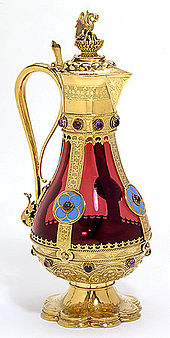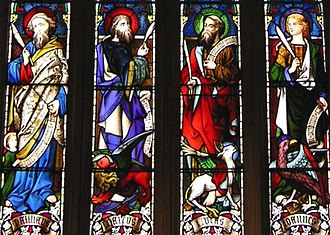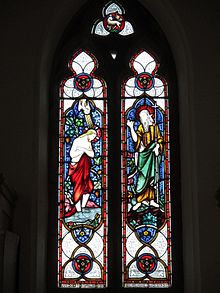Hardman & Co.

Hardman & Co.,otherwiseJohn Hardman Trading Co., Ltd.,founded 1838, began manufacturingstained glassin 1844 and became one of the world's leading manufacturers of stained glass andecclesiasticalfittings. The business closed in 2008.[1]
History
[edit]
John Hardman senior, (1766–1844), ofHandsworth,then inStaffordshire,England (and now part ofBirmingham), was the head of a family business designing and manufacturing metalwork. He was described as the "opulent button maker and medallist".[3] In the 1830sAugustus Welby Puginwas commissioned by theRoman Catholic Bishop,Thomas Walsh, to design a suitable church to house the remains of St Chad, which had been rescued from destruction atLichfield Cathedralduring theReformation.When the building was consecrated in 1841 asSaint Chad's Cathedral,it was the firstRoman Catholiccathedral to be built in England since the Reformation. For the recently converted Catholic, Pugin, this was a commission of great importance.
Pugin first had contact with the John Hardmans during the construction of St Chad's Chapel, the forerunner to the cathedral scheme. John Hardman junior, (1812–67), left the family business in 1838 and set up on his own to manufacture ecclesiastical metalwork. Pugin employed Hardman's to provide metalwork for St Chad's Cathedral. Hardman was an enthusiastic donor, giving the rood screen to the cathedral and being recognised for his provision to various charities by the gift of the Hardman Chantry in which John Hardman senior was interred in 1844, and which remained the family burial place.[4]
From 1845, at the urging of Pugin, John Hardman entered the burgeoning industry of stained glass manufacture. He was joined by his nephew, John Hardman Powell (1827–95) who married Pugin's daughter Anne in 1850, and claimed to be Pugin's only pupil. Powell became the chief designer from about 1849, prior to Pugin's death in 1852. The company took part in theGreat Exhibitionof 1851 in London, exhibiting the great chandelier designed for Alton Towers.
Hardman and Powell collaborated with A. W. Pugin's son,E. W. Pugin,firstly in the design of the funeral arrangements ofJohn Talbot, 16th Earl of Shrewsburyin November 1852. The collaboration between the Hardman firm and the Pugins was to continue after E. W. Pugin's death in 1875 with the later firm, Pugin & Pugin. This collaboration lasted for three generations and was a major influence on Catholic church architecture and decoration in particular and theGothic Revivalin general.
Under the management of J.H. Powell the metalwork design department split from the stained glass department in 1883 and traded under the name Hardman, Powell and Co. Powell died in 1895, passing the leadership of the firm to John Bernard Hardman, the grandson of John Hardman Snr, who headed the company until 1903 and took the firm to theExposition Universelle,Paris. The firm continued producing stained glass in the 21st century under directorship of Donald Taunton and Patrick A. Feeny until the 1970s, and had premises at 26 Frederick Street in theJewellery Quarter,Birmingham, Newhall Hill and Lightwoods House. A large proportion of the Hardman archive, particularly their Medieval Room, was damaged and destroyed in a fire at the Newhall Hill studio in 1970; some of the earliest and most damaged cartoons are now held in temperature controlled storage at Birmingham Museum and Art Gallery. Hardman acquired the stained glass manufacturerGoddard & Gibbsin 2006, but two years later, in 2008, the business closed.[5]
Design
[edit]Gothic Revival
[edit]
Through the influence of A.W.Pugin,John Ruskin,and theOxford Movement,it was considered during the mid-19th century that the only appropriate style in which a church should be built wasGothic.This fashion was combined with a general renewal within the church and a growth ofRoman Catholicism.The result was that many designers in different fields tried to imitate theMedieval stylein their work. This was particularly the case in the stained glass industry.
Pugin, who supplied the first designs for Hardmans, was thoroughly absorbed in the Medieval and was a designer of the highest order. He produced designs of every description- churches, windows, furniture, vestments, vessels, tiles, jewellery and, for the interiors of the Houses of Parliament, Gothic thrones, Gothic hat-stands and Gothic ashtrays. With his busy regime, he increasingly relied upon his talented son-in-law, Powell, to provide the designs for stained glass.
The firm had many subcontractors and designers who are not well-known but produced exceptional work under the Hardman name. For example, thePippet family of Solihull,William John Wainwrightand R.J. Hopkins.[6]
John Hardman Powell
[edit]Powell's stained glass recreates the elegance, the refinement, the brevity that is seen in some of the finest examples of glass, sculpture and illumination of the 13th and 14th centuries. He utilised the flowing, curving lines, the flourish of drapery, the calligraphic brushstrokes and pure colour. However, Powell's work was not, like many stained glass designers, merely imitative. His designs are original innovations in the Gothic style. The quality of Hardman's church windows, particularly in the 1850s and 1860s, was superb.

Major commissions
[edit]The most famous building that the Hardmans made glass for was the newHouses of Parliamentin London, for which Pugin was the interior designer. Pugin employed the Scottish firm ofBallantine and Allento manufacture the windows that he designed for the House of Lords, but all the rest were made by Hardmans, who have maintained their relationship with that building, repairing and replacing glass damaged or destroyed during World War II.
Apart from the windows created for Pugin's churches in England andIreland,two of Hardman's major commissions were to come from Australia. In the 1860s the architectEdmund Blacketcommissioned Hardmans to supply 27 windows, including a 6-light West window and a 7-light East window forSt. Andrew's Cathedral, Sydney.They were installed for the consecration in 1868.
In the 1880sWilliam Wardellselected the same firm to provide windows forSt. Mary's R.C. Cathedralin the same city. This building, of which the nave was not completed until the 1930s, is very much larger than St Andrew's and has three large rose windows and an enormous East window, the tracery of which was based directly on that of Lincoln Cathedral, c.1280. The design of this huge window, depicting the Coronation of theBlessed Virgin Maryis one of the pinnacles of achievement inGothic Revivalstained glass.
Buildings with glass by Hardmans
[edit]



England
- St. Nicholas' Church,Newbury,Berkshire
- Sandhurst Royal Memorial Chapel,Sandhurst,Berkshire
- St. Michael and All Angels' Church, Sandhurst, Berkshire
- St. Paul's Church,Wokingham,Berkshire
- St Pauls' Church,Clifton,Bristol
- St. Mary's Church,St Neots,Cambridgeshire
- Our Lady and St. Wilfrid's Church,Warwick Bridge,Cumbria
- St. Hieritha's Church,Chittlehampton,Devon
- Wynard's Chapel,Exeter,Devon
- Holy Trinity Church,Ilfracombe,Devon
- Gloucester Cathedral,Gloucester,Gloucestershire
- St. Peter's Church,Gloucester, Gloucestershire
- Tewkesbury Abbey,Tewkesbury,Gloucestershire
- St. Michael the Archangel's Church,Felton,Herefordshire
- St. Margaret's Church,Halstead,Kent
- St. Catherine's Church,Kingsdown,Kent
- Our Lady and St. Hubert's Catholic Church,Great Harwood,Lancashire
- St. Peter and St. Paul's Church,Algakirk,Lincolnshire
- St. Nicholas' Church,Lincoln,Lincolnshire
- Our Ladye Star of the Sea Church,Greenwich,London
- St. Peter's Roman Catholic Church,Woolwich,London
- St. James' Church,Heywood,Greater Manchester
- St. Margaret's Church,Clenchwarton,Norfolk
- All Saints' Church,Dickleburgh,Norfolk
- St. Andrew's Church,Framingham Pigot,Norfolk
- St. John the Baptist Cathedral,Norwich,Norfolk
- Holy Cross Church,Byfield,Northamptonshire
- All Saints' Church,Dunsden Green,Oxfordshire
- St. Lawrence's Church,North Hinksey,Oxfordshire
- St. Michael and St. James' Church,Haunton,Staffordshire
- Cranleigh School Chapel,Cranleigh,Surrey
- St Nicolas Church,Cranleigh,Surrey
- [[St Mary Magdalen's Church,
Brighton|St. Mary Magdalen's Church]],Brighton,East Sussex
- Arundel Cathedral,Arundel,West Sussex
- Arundel Castle,Arundel, West Sussex
- St. Joseph's Roman Catholic Church,Avon Dassett,Warwickshire
- St. Chad's Cathedral,Birmingham,Warwickshire
- St. Augustine's Church,Edgbaston,Warwickshire
- St. Mary Magdalene's Church,Great Alne,Warwickshire
- St. Cyprian's Church,Hay Mills,Warwickshire
- All Saints' Church,Ladbroke,Warwickshire
- St. Laurence's Church,Northfield,Warwickshire
- St. Mary's Church,Selly Oak,Warwickshire
- Worcester Cathedral,Worcester,Worcestershire
- St. Agatha's Church,Gilling West,North Yorkshire
- St. Mary and St. Romuald's Church,Yarm,North Yorkshire
- Church of St. Nicholas,High Bradfield,South Yorkshire
- All Souls' Church,Halifax,West Yorkshire
- Meanwood Towers,Meanwood,West Yorkshire
Northern Ireland
- St. Patrick and St. Colman's Cathedral,Newry,County Armagh
Scotland
- St. Patrick's Church,Anderston,Lanarkshire
Australia
- Sacred Heart Convent Chapel,Ballarat,Victoria
- St. Andrew's Cathedral,Sydney,New South Wales
- St John's College, University of Sydney,New South Wales
- St. Edward's Catholic Church,Canowindra,New South Wales
- St. Francis Xavier's Cathedral,Geraldton,Western Australia
- St. Mary's Cathedral,Sydney, New South Wales
- St. Patrick's Cathedral, Ballarat, Victoria
- St. Stanislaus' College Bathurst,Bathurst, New South Wales.
United States of America
- St. Peter Chanel Catholic Church,Roswell,Georgia
- Grace and St. Peter's Church,Baltimore,Maryland
See also
[edit]
Other early 19th-century firms
[edit]Context
[edit]- Stained glass
- British and Irish stained glass (1811–1918)
- Victorian era
- Gothic Revival
- Poor Man's Bible
References
[edit]Notes
- ^"Final Meetings".london-gazette.co.uk.Retrieved11 April2018.
- ^"Flagon".Metalwork.Victoria and Albert Museum.Retrieved9 December2007.
- ^Roderick O'Donnell, The Pugins and the Catholic Midlands.
- ^St Chads Cathedral websitehttps:// stchadscathedral.org.uk/cathedral/heritage/
- ^Shand, William, and Wallington-Smith, Andrew,Heraldry and Stained Glass at Apothecaries' Hall,(2020: Philip Wilson), p 246.
- ^Bill Covington, 'J.A Pippet and Hardman, Powell & Company', True Principles, vol. 2 No. 3, 2001
Bibliography
- John Hardman Trading Co., Ltd.,
- Roderick O'Donnell,The Pugins and the Catholic Midlands,Gracewing, Archdiocese of Birmingham Historical Commission, 2002
- Elizabeth Morris,Stained and Decorative Glass,Doubleday,ISBN0-86824-324-8
- Sarah Brown,Stained Glass: an Illustrated History,Bracken Books,ISBN1-85891-157-5
- Simon Jenkins,England's Thousand Best Churches,Allen Lane, the Penguin Press,ISBN0-7139-9281-6
- John Harvey,English Cathedrals,Batsford, 1961, ISBN unknown
- Robert Eberhard,Church Stained Glass Windows,[1][permanent dead link]
- Cliff and Monica Robinson,Buckinghamshire Stained Glass,[2]Archived5 September 2015 at theWayback Machine
- Mathé Shepheard,The Stained Glass of John Hardman and Company under the leadership of John Hardman Powell from 1867 to 1895,
- Bill Covington, 'J.A Pippet and Hardman, Powell & Company', True Principles, vol. 2 No. 3, 2001[3]
- Michael J. Fisher, "Hardman of Birmingham; Goldsmith and Glasspainter", Landmark Publishing. 2008,ISBN9781843063629
- Michael J. Fisher, "Guarding the Pugin Flame - John Hardman Powell 1827-1895", Spire Books 2017ISBN978-1-904965-51-0
